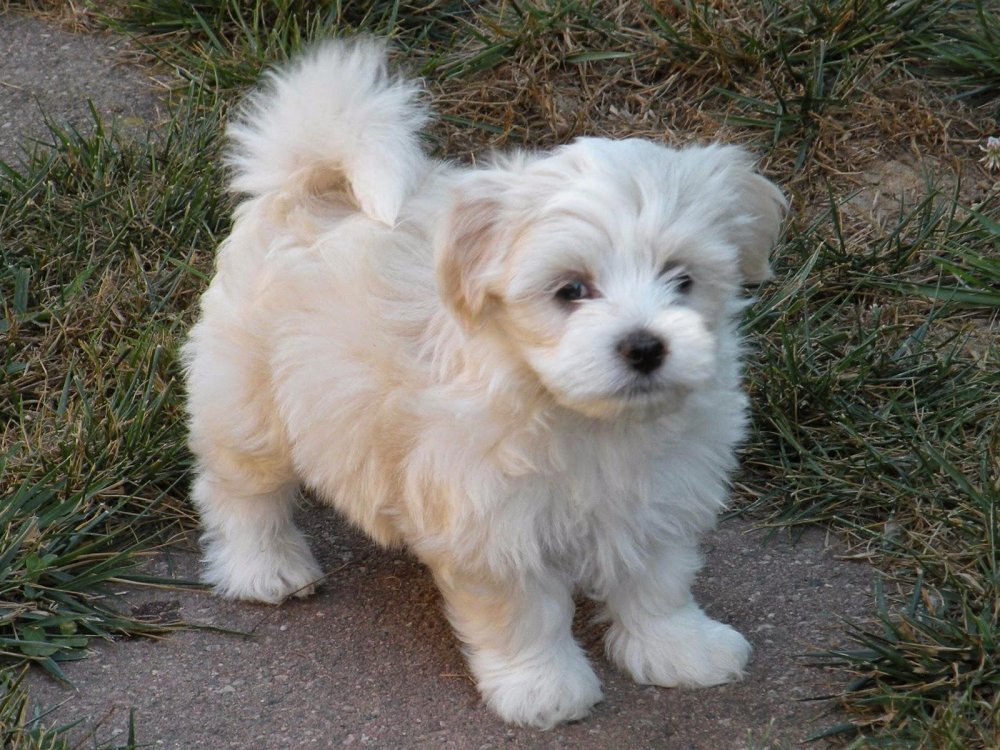- Breed Category: Toy Group
- Country of Origin: Cuba
- Average Height: 23-27 cm (9-11 inches)
- Average Weight: 4.5-7.3 kg (10-16 pounds)
- Average Life Span: 14-16 years
- Grooming Requirements: Regular brushing and trimming
- Exercise Requirements: Moderate daily exercise
- Coat Type: Silky, long, and wavy
- Coat Color Variations: White, black, cream, and more
- Shedding Level: Low
- Ear Type: Drop ears
- Tail Type: Plumed, carried over back
- Temperament: Affectionate, playful, and friendly
- Intelligence Level: High
- Barking Tendency: Moderate
- Compatibility with Children: Very good
- Compatibility with Other Pets: Generally good
- Training Ease: Relatively easy
- Common Health Issues: Cataracts, hip dysplasia
- Dietary Needs: High-quality balanced diet
- Energy Level: Moderate
- Drooling Tendency: Low
- Sensitivity to Weather: Sensitive to cold
- Overall Maintenance Level: Moderate
- Original Purpose: Companion dog
- Year of Recognition by Kennel Clubs: 1996
- Apartment Friendly: Yes
- Best Suited For: Families, singles, seniors
- Cost of Ownership: Moderate
- Unique Traits: Velcro dog, loves companionship
- Cultural Significance: National dog of Cuba
- Popularity Rank: Increasingly popular
Choosing the right dog breed can be a bit overwhelming, especially when you’re looking for a companion that fits your lifestyle. Enter the Havanese, a delightful breed known for its friendly nature and charming looks. This article aims to give you a clear picture of what makes the Havanese so special, from their unique characteristics to their rich history and how best to care for them.
The Havanese has a fascinating backstory. Originating from Cuba, they were once the beloved pets of Cuban aristocracy. Their journey to becoming a popular breed worldwide is as captivating as their playful antics. Understanding their history not only enriches your appreciation for them but also helps in providing the best care for these adorable companions.
The Havanese: A Breed with a Rich History

Early Development of the Breed
The Havanese breed traces its roots back to the 16th century when Spanish settlers brought small companion dogs to Cuba. Over time, these dogs adapted to the island’s climate and lifestyle, evolving into the charming Havanese we know today. Their silky coats and lively personalities made them favourites among the Cuban elite.
Role in Cuban Society and as a Companion Dog
In Cuba, the Havanese were more than just pets; they were status symbols. Their presence in the homes of the wealthy highlighted their role as cherished companions. Even today, their friendly and affectionate nature makes them ideal family dogs, bringing joy and companionship to households worldwide.
Key Historical Figures and Events
During the Cuban Revolution, many Havanese were brought to the United States by fleeing families, ensuring the breed’s survival. This migration played a crucial role in their global popularity. Key figures in the breed’s history include dedicated breeders who worked tirelessly to preserve their unique traits.
Physical Characteristics
Havanese dogs are small but sturdy, with a height of about 23 to 27 centimetres. Their long, flowing coats come in a variety of colours, adding to their appeal. Despite their size, they are surprisingly agile and energetic, making them perfect for both play and cuddles.
Appearance and Unique Physical Traits
The Havanese is a small yet robust breed, typically standing between 23 to 27 centimetres tall. Their size makes them perfect for both apartment living and larger homes. One of their most striking features is their silky, flowing coat, which can come in a wide range of colours, from pure white to black, and everything in between. Some even sport unique markings, adding to their individual charm. This luxurious coat isn’t just for show; it provides protection and adds to their overall appeal.
Temperament and Behaviour
When it comes to temperament, the Havanese is a true delight. They’re known for their friendly and outgoing nature, making them excellent companions for families and singles alike. These dogs are incredibly social and thrive on interaction, whether it’s playtime with the kids or a quiet evening on the couch. Their intelligence and eagerness to please make them easy to train, while their playful antics keep everyone entertained. Despite their small stature, they have a big personality, full of energy and affection.
Personality and Suitability as a Family Pet

Typical Personality Traits
The Havanese is a bundle of joy wrapped in a silky coat. They’re affectionate, intelligent, and playful, making them a favourite among dog lovers. Their friendly nature means they quickly become a part of the family, always ready to offer a wagging tail and a warm cuddle. These dogs are not just about fun and games; their intelligence shines through in their ability to learn new tricks and commands with ease.
Suitability as a Family Pet and Companion Dog
As a family pet, the Havanese ticks all the right boxes. They’re adaptable, thriving in both bustling households and quieter settings. Their small size makes them ideal for apartment living, yet they’re equally at home in larger spaces. Their affectionate nature ensures they bond well with all family members, providing companionship and joy.
Interaction with Children and Other Animals
Havanese dogs are known for their gentle and friendly disposition, making them great companions for children. They enjoy playtime and are patient with little ones, often forming strong bonds. When it comes to other animals, their social nature means they usually get along well, whether it’s with other dogs or even cats.
Training and Exercise Needs
Training a Havanese is a rewarding experience. Their eagerness to please and intelligence make them quick learners. Consistent, positive reinforcement works wonders. While they don’t require extensive exercise, regular walks and play sessions keep them happy and healthy. Their playful spirit means they’ll happily join in on family activities, ensuring they’re always part of the action.
Training, Exercise, and Health of the Havanese

Importance of Early Training and Socialisation
Getting your Havanese started with training and socialisation early on is crucial. These little dogs are naturally social, but introducing them to different environments, people, and other animals helps them grow into well-rounded companions. Early training sets the foundation for good behaviour and strengthens your bond with them.
Recommended Training Techniques
Havanese respond well to positive reinforcement techniques. Use treats, praise, and play to reward good behaviour. Keep training sessions short and fun to maintain their interest. Consistency is key, so make sure everyone in the household is on the same page with commands and rules.
Daily Exercise Requirements and Activities They Enjoy
While the Havanese doesn’t need hours of exercise, they do enjoy daily walks and playtime. A couple of short walks and some interactive play sessions will keep them happy. They love games like fetch and enjoy learning new tricks, which also provides mental stimulation.
Health and Lifespan
Havanese are generally healthy dogs with a lifespan of 14 to 16 years. Regular vet check-ups, a balanced diet, and proper grooming are essential to keep them in top shape. Be mindful of common issues like eye problems and hip dysplasia, and consult your vet for any concerns.
Health and Care for Your Havanese

Common Health Issues
Havanese dogs are generally healthy, but like all breeds, they’re prone to certain health issues. Keep an eye out for eye disorders, hip dysplasia, and heart conditions. Regular vet visits can help catch these early, ensuring your furry friend stays in top shape.
Average Lifespan and Health Tips
With proper care, a Havanese can live between 14 to 16 years. To keep them healthy, provide a balanced diet, regular exercise, and mental stimulation. These little dogs thrive on interaction, so make sure they get plenty of playtime and socialisation.
Preventative Care Recommendations
- Schedule regular vet check-ups to monitor their health.
- Keep vaccinations up to date to prevent common diseases.
- Maintain a healthy weight through a balanced diet and exercise.
- Brush their teeth regularly to prevent dental issues.
Grooming and Maintenance
The Havanese’s silky coat requires regular grooming to prevent tangles and mats. Brush them a few times a week and bathe them as needed. Regular ear checks and nail trims are also important to keep them comfortable and healthy.
Coat Care and Grooming Routines
Shedding and Seasonal Grooming Tips
The Havanese is known for its luxurious, silky coat, which requires regular attention to keep it looking its best. Unlike some breeds, they don’t shed much, but their hair can tangle and mat if not properly maintained. Regular brushing, at least two to three times a week, is essential to prevent knots and keep their coat healthy. During seasonal changes, you might notice a bit more shedding, so it’s a good idea to increase grooming sessions during these times.
Bathing your Havanese every few weeks will help keep their coat clean and shiny. Use a gentle dog shampoo to avoid skin irritation. Regular ear checks and nail trims are also part of their grooming routine, ensuring they stay comfortable and healthy.
Diet and Nutrition
A balanced diet is crucial for the overall health and well-being of your Havanese. High-quality dog food, rich in protein and essential nutrients, supports their energy levels and maintains their coat’s lustre. Portion control is important to prevent obesity, a common issue in small breeds. Treats should be given in moderation, and it’s always a good idea to consult your vet for specific dietary recommendations tailored to your dog’s needs.
Nutritional Needs and Feeding for Your Havanese

Foods to Include and Avoid
Feeding your Havanese a balanced diet is key to their health. Opt for high-quality dog food rich in protein, healthy fats, and essential vitamins. Look for ingredients like chicken, fish, and vegetables. Avoid foods with artificial additives, fillers, and excessive grains, as these can lead to allergies and digestive issues.
Feeding Schedules and Portion Recommendations
Establishing a regular feeding schedule helps maintain your Havanese’s energy levels and prevents overeating. Typically, two meals a day are sufficient for adult dogs, while puppies may need three to four smaller meals. Portion sizes depend on their age, weight, and activity level, so consult your vet for tailored advice.
Fun Facts and Trivia
Did you know the Havanese is the national dog of Cuba? Their charming personality and adaptability have made them a favourite among dog lovers worldwide. Despite their small size, they have a surprisingly robust constitution, often living well into their teens with proper care.
Interesting Tidbits and Famous Havanese Dogs
Interesting Tidbits about the Breed
The Havanese is not just a pretty face; they have some intriguing traits that make them stand out. For starters, their coat is hypoallergenic, making them a great choice for allergy sufferers. Despite their small size, they are known for their agility and can excel in dog sports like agility and obedience. Their expressive eyes and lively gait are often compared to those of a little clown, always ready to entertain and bring a smile to your face.
Famous Havanese Dogs in Media or History
Havanese dogs have made their mark in the world of media and history. One of the most famous Havanese is “Cuba,” the beloved pet of Charles Dickens. This breed has also graced the silver screen, with appearances in movies and TV shows, often cast for their charming looks and endearing personality. Their popularity among celebrities has further cemented their status as a sought-after companion, with stars like Barbara Walters and Venus Williams counting them as part of their family.
Final Thoughts

The Havanese is a delightful companion with a rich history. Their affectionate nature and adaptability make them ideal for various households. From their Cuban origins to their modern-day popularity, the Havanese offers a blend of charm and companionship that enriches any family. With proper care and attention, these dogs thrive, bringing joy and warmth to their owners. Consider welcoming a Havanese into your home and experience the joy of this unique breed.
